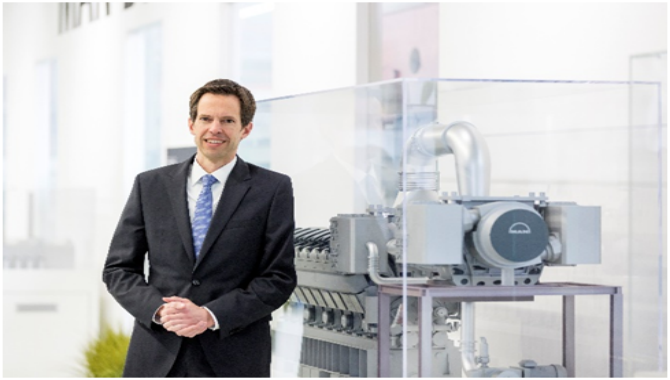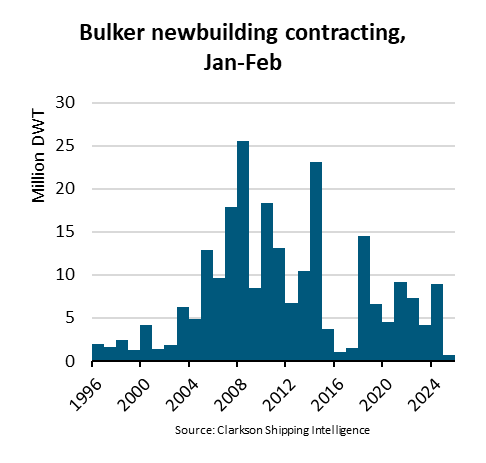Since the first dual-fuel (DF) gas engines were installed in LNG carriers in the 1990s, they have not only become the prime movers of choice in this sector. The LNG carrier application has been an important proving ground for high efficiency DF gas engines, which are now being installed in a wider range of vessels, such as container ships, bulkers, ferries and cruise ships, to address commitments to reduce of carbon dioxide (CO2) and other greenhouse gas (GHG) emissions from large marine engines.
The basis of this trend is the low carbon to hydrogen ratio of the methane in natural gas – CH4 is the simplest combination of hydrogen and carbon and hence methane has the lowest carbon content of any hydrocarbon. This factor enables CO2 emissions from low and medium speed marine engines to be reduced by around 25% compared to other fossil fuels. With this initial GHG benefit, DF gas engines burning natural gas –and sourced as boil-off gas on LNG carriers and stored as LNG on other vessel types –havebecome the vital starting point in a maritime energy transition that envisages a stage-by-stage shift from methane to zero carbon and carbon-neutral synthetic fuels in large marine – and stationary – engines.
Turning to methane as the first transitional stage between fossil fuels and new synthetic fuels brings its own particular challenge, however: minimizing methane slip. Gunnar Stiesch, head of the technology department at MAN Energy Solutions outlines the issue. “In engine technology, methane slip denotes the fuel that evades combustion in gas engines and is emitted via the engine exhaust. Without countermeasures there are a several routes by which methane can escape unburnt into the atmosphere from both two- and four-stroke gas-burning engines operating on the Otto combustion process.” he notes. “The issue is vital because methane typically makes up 85–95 percent of natural gas and is a potent greenhouse gas (GHG) with a significantGlobal Warming Potential (GWP). It can trap 86 times more heat in the atmosphere than CO2 over 20 years, and about 30 times more over 100 years.”

Dr Gunnar Stiesch, Chief Technical Officer and Member of the Executive Board, MAN Energy Solutions
Hence, even though the volume of methane escaping combustion in MAN’s engines are small as a percentage of the exhaust gases, its GHG effect is significant. Moreover, as well as a source of GHG leakage into the atmosphere, methane-slip is also wasted fuel, not converted into energy.
“Minimizing methane slip will, thus, be a major contribution to meeting the GHG reductions from the shipping industry set out in the International Maritime Organization’s “Initial Strategy”. This document sets out reductions in the carbon intensity of international shipping by at least 40% by 2030, on the way to 70% by 2050 (compared to 2008 baseline), and that total annual GHG emissions from international shipping should be reduced by at least 50% by 2050 compared to 2008.”
Fully aware that the economic and emissions benefits of natural gas can only be leveraged fully when methane-slip is resolved, MAN’s designers and developers of both two- and four-stroke gas-burning engines have been engaged for some time in minimising methane-slip from both its dual-fuel and its pure gas spark-ignited (SI) engines.Of MAN’s two engine types operating on the DFprinciple, two- and four-stroke, the focus is on four-stroke DF engines operating according to the Otto combustion process.
The reasoning here is simple: MAN is already offering large low speed, two-stroke DF gas engines – of the type popular in large merchant vessels – whose combustion technology which eliminatesmethane-slip at source. “By their very operating principle our ME-GI two-stroke DF engines with high pressure gas injection limit methane slip to a range between 0.2–0.3 grams per kWh. These engines operate on the Diesel combustion process in which the gaseous fuel is injected at high pressure directly into hot compressed air, with the piston near top-dead-centre and the exhaust valve closed, and slightly later than the “pilot” fuel which ignites it. This ensures very complete, fuel-efficient combustion with maximised heat release. In other words, there is no route for the directly injected methane to escape combustion and reach the atmosphere.”
Able to provide an effective solution to methane-slip in its two-stroke DF range, MAN is in a positionto quantify methane-slip levels in g/kWh and guarantee them throughout the engine load range. In addition, in terms of overall GHG emissions, as well as the benefit of negligible near-zero methane slip, the higher compression ratio associated with Diesel combustion and direct gas injection in the ME-GI two-stroke DF engines ensure very low specific fuel consumption and thus very low CO2 emissions combined with very stable operation on all commercially available grades of LNG. “As a result, MAN’s ME-GI low-speed DF engines with direct gas injection are the only marine engines presently capable of these negligible levels of methane slip,” Stiesch adds.
Moving to the medium speed side, there are aspects of four-stroke DF gas engine operating with the Otto combustion process which, without countermeasures, provide routes for methane to evade combustion and reach the atmosphere. Consequently, MAN has been addressing methane-slip on its four-stroke DF engines ever since their introduction in the mid-2000s. “We can already point to a halving of unburnt methane emissions from our 51/60 DF engine since its market launch and the process is continuing,with the findings being applied to all our four-stroke DF engines.” Stiesch observes. “All MAN's medium speed four-stroke DF engines operate on the Otto combustion process, where gaseous fuel is pre-mixed with air and the mixture admitted to the cylinder before compression. After compression it is ignited by a liquid fuel “micro- pilot”representing less than 1% of the total heat release from both fuels. Thus, the fuel/air mixture is in the cylinder for all of the induction and compression strokes and part of the power stroke when valves are opening and closing.”
Source: Jonathan Walker, Freelance Engine Journalist
The opinions expressed herein are the author's and not necessarily those of The Xinde Marine News.
Please Contact Us at:
media@xindemarine.com


 Ningbo Containerized Freight Index Weekly Commentar
Ningbo Containerized Freight Index Weekly Commentar  Ningbo Containerized Freight Index Weekly Commentar
Ningbo Containerized Freight Index Weekly Commentar  Ningbo Containerized Freight Index Weekly Commentar
Ningbo Containerized Freight Index Weekly Commentar  BIMCO Shipping Number of the Week: Bulker newbuildi
BIMCO Shipping Number of the Week: Bulker newbuildi  Ningbo Containerized Freight Index Weekly Commentar
Ningbo Containerized Freight Index Weekly Commentar  Ningbo Containerized Freight Index Weekly Commentar
Ningbo Containerized Freight Index Weekly Commentar